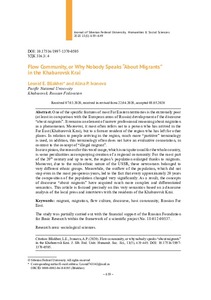Показать сокращенную информацию
Flow Community, or Why Nobody Speaks “About Migrants” in the Khabarovsk Krai
| Автор | Bliakher, Leonid E. | en |
| Автор | Ivanova, Alina P. | en |
| Автор | Бляхер, Л.Е. | ru_RU |
| Автор | Иванова, А.П. | ru_RU |
| Дата внесения | 2020-05-31T01:37:13Z | |
| Дата, когда ресурс стал доступен | 2020-05-31T01:37:13Z | |
| Дата публикации | 2020-05 | |
| URI (для ссылок/цитирований) | https://elib.sfu-kras.ru/handle/2311/135295 | |
| Аннотация | One of the specific features of most Far Eastern territories is the extremely poor (at least in comparison with the European areas of Russia) development of the discourse “about migrants”. It remains an element of narrow professional reasoning about migration as a phenomenon. Moreover, it most often refers not to a person who has arrived in the Far East (Khabarovsk Krai), but to a former resident of the region who has left for other places. In relation to people arriving in the region, much more “partitive” terminology is used, in addition, this terminology often does not have an evaluative connotation, in contrast to the concept of “illegal migrant”. In our opinion, the reason for this word usage, which is not quite usual for the whole country, is some peculiarities accompanying creation of a regional community. For the most part of the 20th century and up to now, the region’s population enlarged thanks to migrants. Moreover, due to the multi-ethnic nature of the USSR, these newcomers belonged to very different ethnic groups. Meanwhile, the outflow of the population, which did not stop even in the most prosperous years, led to the fact that every approximately 20 years the composition of the population changed very significantly. As a result, the concepts of discourse “about migrants” have acquired much more complex and differentiated semantics. This article is focused precisely on this very semantics based on a discourse analysis of the local press and interviews with the residents of the Khabarovsk Krai | en |
| Аннотация | Одной из специфических черт большинства дальневосточных территорий является крайне слабое, во всяком случае, по сравнению с европейскими губерниями страны, развитие дискурса «о мигрантах». Он остается элементом узкопрофессиональных рассуждений о миграции, как феномене. Причем, чаще относится не к человеку, приехавшему на Дальний Восток (Хабаровский край), но к бывшему жителю региона, отбывшему в иные дали. В отношении прибывающих в край лиц используется гораздо более «дробная» терминология, которая часто не имеет оценочной коннотации, в отличие от концепта «нелегальный мигрант». Причиной такого, не вполне обычного для страны словоупотребления, на наш взгляд, выступает особенность формирования регионального сообщества. На протяжении большей части ХХ века и до настоящего времени население региона формировалось за счет приезжих. Причем, в силу полиэтнического характера СССР, приезжие эти принадлежали к самым разным этносам. При этом отток населения, не прекращавшийся и в самые благополучные годы, приводил к тому, что, примерно, каждые 20 лет состав населения очень существенно изменялся. В результате, понятия дискурса «о мигрантах» приобрели гораздо более сложную и дифференцированную семантику. О ней, применительно к территории Хабаровского края, на основе дискурс-анализа местной прессы и интервью с жителями региона и пойдет речь в статье | ru_RU |
| Язык | en | en |
| Издатель | Сибирский федеральный университет. Siberian Federal University | en |
| Тема | migrant | en |
| Тема | migration | en |
| Тема | flow culture | en |
| Тема | discourse | en |
| Тема | host community | en |
| Тема | Russian Far East | en |
| Тема | мигрант | ru_RU |
| Тема | миграция | ru_RU |
| Тема | проточная культура | ru_RU |
| Тема | дискурс | ru_RU |
| Тема | принимающее сообщество | ru_RU |
| Тема | Дальний Восток России | ru_RU |
| Название | Flow Community, or Why Nobody Speaks “About Migrants” in the Khabarovsk Krai | en |
| Альтернативное название | Проточная общность, или почему в Хабаровском крае не говорят «о мигрантах» | ru_RU |
| Тип | Journal Article | en |
| Контакты автора | Bliakher, Leonid E.: Pacific National University Khabarovsk, Russian Federation; Leonid743342@mail.ru; ORCID: 0000-0002-0610-9395 | en |
| Контакты автора | Ivanova, Alina P.: Pacific National University Khabarovsk, Russian Federation | en |
| Контакты автора | Бляхер, Л.Е.: Тихоокеанский государственный университет Российская Федерация, Хабаровск | ru_RU |
| Контакты автора | Иванова, А.П.: Тихоокеанский государственный университет Российская Федерация, Хабаровск | ru_RU |
| Страницы | 639–649 | ru_RU |
| DOI | 10.17516/1997-1370-0595 | |
| Журнал | Журнал Сибирского федерального университета. Гуманитарные науки. Journal of Siberian Federal University. Humanities & Social Sciences;2020 13 (5) | en |

